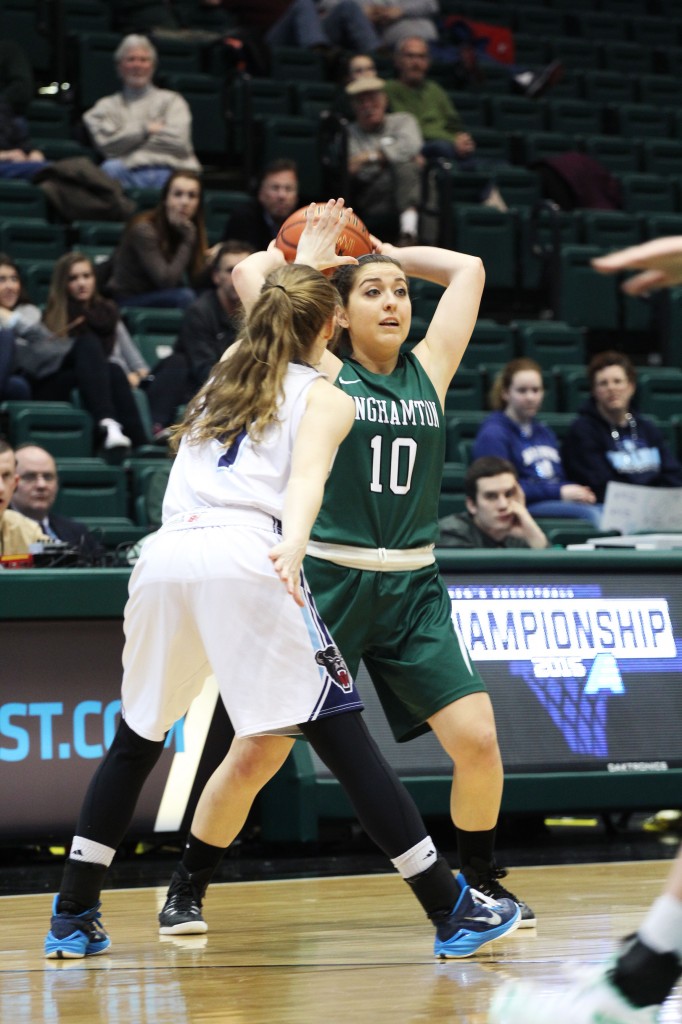
Through the weekend of March 7, Binghamton University hosted the first two rounds of the America East women’s basketball tournament. The two-day event featured a field of eight teams playing six games on just one court. Four quarterfinal games were played through 11 hours on Saturday, and four teams returned to the Events Center for two semifinal match-ups on Sunday.
As one might imagine, that required a good deal of planning. According to Shonna Brown, senior associate commissioner of the America East and tournament director, it was four pages worth.
“I think there’s a checklist of about four pages long,” Brown said. “But we go through everything. What’s the route for the busses to take onto campus? … We worked on credentials — how many participant passes, how many event staff, how many all-access for administrators? We worked with our television partners to make sure that we’re getting the windows that we need in order to have the game times set.”
The list went on.
In conjunction with Binghamton University’s administration — mostly Director of Athletics Patrick Elliott and Associate Director of Athletics of Internal Operations and Events Leigh Ann Savidge-Morris — Brown planned everything from putting all seven visiting teams up in the DoubleTree by Hilton Binghamton in Downtown Binghamton to measuring every inch of the arena, including its chair backs, to appropriate it for America East signage and branding.
“We were just trying to figure out, when the student-athletes and the fans come to the Events Center, how do we make it feel like they’re not just showing up for another basketball game?” Brown said.
Between a video board suspended from the ceiling on the far side of the arena playing highlight clips of the players and teams to blue and white America East logos printed on nearly everything in sight, that was successful enough for one visiting team.
“One of the teams did come up afterwards and say, ‘You know, it felt like we were at an NCAA tournament. It really felt different than when we showed up at Binghamton for our regular season game,’” Brown said. “And that’s what we really try to accomplish.”
It’s that sort of atmosphere that made the women’s basketball coaches vote to retain the central tournament structure while the men’s coaches opted for the higher seed format. While the higher seed style surely has its advantages — ensuring that deserving teams play behind a home-court advantage, increasing fan attendance and allowing more flexibility in scheduling being just a few of them — it has the potential to just feel like any other game.
On the other hand, bringing all the teams together at one venue and putting them up at the same hotel cultivated a unique tournament experience. Unlike the men’s side, it additionally allowed the women’s programs to congregate the Friday before the tournament for the awards banquet. After sharing a dinner, the womens’ coaches, players and personnel received their awards and were recognized in front of their peers before going head-to-head the following day.
“That’s just a really great opportunity for us to celebrate women’s basketball,” Brown said. “I think our women’s basketball players and coaches both really like coming together and having that more tournament feel and environment to it.”
All of the weekend’s events were a culmination of the AE’s schools’ athletics directors’ vote from last March. One of four AE institutions to submit a bid to host the tournament through 2015 and 2016, Binghamton was selected not only for quantitative considerations — the schools have to propose a budget that documents all the anticipated expenses — but for qualitative ones as well.
According to Elliott and Brown, the most important factor taken into account is the student-athlete experience. While facility, fan capacity, staffing, ability to accommodate signage and branding as well as video boards and ESPN3 broadcasters all factored into the decision, student-athlete experience was at the core of it all.
“It’s more than just the basketball going up in the air and the games happening around it,” Brown said. “It’s the environment, it’s the feel, it’s the band, it’s the support, it’s people coming out from the community and buying tickets and supporting the event.”
As far as costs were concerned, Brown said that the AE has “99 percent of the time covered 100 percent of the expenses.” The budget included in the proposal is funded by the conference, while anything over the approved expenditure falls on the host university. Additionally, the university covers the costs of its staff and normal operations.
The weekend marked the first time the Bearcats played host since 2007 but certainly not the last, as Binghamton is set to welcome back its competition to the Events Center in 2016. Come next March, however, the coaches will be able to reconsider the tournament formats. While this was the first year that the women’s and men’s programs played different postseason structures, they may be able to get on the same wavelength yet again, if they so decide.
“I think what we want to do is, how best as a conference can we position and brand women’s basketball and men’s basketball?” Elliott said. “And I think ultimately that will be the decision.”
“These student-athletes work hard, and they deserve to feel special in their tournament,” Elliott added. “And I think that the central tournament allows that to happen. But at the same time you could argue that if you’re on your home court and you’ve got 5,000 screaming fans, you know, that makes you feel pretty special, too.”


